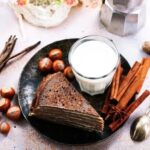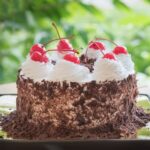Are you wondering how to decorate a naked wedding cake for your upcoming nuptials? Naked wedding cakes have been gaining popularity in recent years, offering a rustic and elegant alternative to traditional frosted confections. In this article, we will explore the trend and appeal of naked wedding cakes, providing step-by-step guidance on how to create and decorate your own stunning dessert for the big day.
For modern couples seeking a more natural and pared-down aesthetic for their weddings, naked cakes have become a popular choice. With their exposed layers and minimal frosting, these cakes exude a charming simplicity that perfectly complements a variety of wedding themes, from bohemian outdoor celebrations to intimate garden gatherings.
The appeal of naked wedding cakes lies in their versatility and ability to showcase the natural beauty of the cake itself, making them an ideal choice for those looking to add a touch of understated elegance to their special day.
Choosing the right cake flavor is crucial when it comes to creating a delectable naked wedding cake. From classic vanilla and rich chocolate to tangy lemon and luscious red velvet, there are endless options to suit different preferences and complement the overall wedding theme and season.
In the following sections, we will delve into the process of preparing, filling, stacking, frosting, and decorating your naked wedding cake, providing expert tips and techniques for achieving an exquisite finish that will impress your guests.
Choosing the Right Cake Flavor
When it comes to choosing the right cake flavor for a naked wedding cake, there are several factors to consider. The flavor of the cake should not only complement the overall wedding theme and decor but also cater to the preferences of the couple getting married. Some popular cake flavors and fillings for naked wedding cakes include:
- Vanilla: A classic choice that appeals to a wide range of tastes. Vanilla cake pairs well with various fillings such as raspberry, lemon curd, or chocolate ganache.
- Lemon: Perfect for spring or summer weddings, a lemon-flavored cake adds a refreshing and tangy touch to the dessert table. Pair it with options like blueberry compote or lavender buttercream for a delightful combination.
- Chocolate: For couples who love rich and decadent flavors, a chocolate naked wedding cake can be a showstopper. Consider fillings like salted caramel, peanut butter mousse, or fresh berries to elevate the taste.
- Red Velvet: With its striking color and subtle cocoa flavor, red velvet cake is an eye-catching choice for weddings. Cream cheese frosting or berry preserves can enhance the flavor profile of this indulgent option.
In addition to selecting the right flavors, it’s important to match them with the wedding theme and season. For example, lighter flavors like lemon and raspberry may be more suitable for a spring or summer wedding, while richer options like chocolate and red velvet are perfect for fall or winter celebrations. By considering both personal preferences and seasonal influences, couples can create a delicious naked wedding cake that perfectly complements their special day.
Preparing the Cake Layers
When it comes to preparing the cake layers for a naked wedding cake, achieving the perfect texture is essential for a visually appealing and delicious result. Whether you’re a professional baker or a DIY bride, following a step-by-step guide can help you create the ideal base for your naked wedding cake.
Choosing the Right Cake Recipe
The first step in preparing the cake layers for a naked wedding cake is choosing the right cake recipe. For naked cakes, it’s important to select flavors that are not overly sweet or rich, as the lack of frosting means all the focus will be on the cake itself. Popular choices include vanilla, lemon, almond, and carrot flavors. It’s also important to consider any dietary restrictions or allergies among your guests when choosing your cake flavors.
Baking and Preparing the Layers
Once you’ve selected your cake flavor, it’s time to bake and prepare the layers. Follow your chosen recipe carefully, ensuring that you measure ingredients accurately and follow baking instructions closely. To achieve a moist and tender texture, consider adding simple syrup to each layer before assembly. This will add moisture without making the cake too sweet.
Tips for Achieving the Perfect Texture
To ensure that your naked wedding cake has the perfect texture, it’s essential to pay attention to detail throughout the baking and preparation process. Be sure to level each layer of cake before stacking them to create an even surface for filling and frosting.
Additionally, consider chilling your assembled layers before applying any fillings or frostings – this will help create a sturdy structure and prevent sliding or collapsing. Finally, don’t rush through this process; taking your time with each step will ultimately result in a beautifully textured naked wedding cake that will impress your guests on your special day.
Filling and Stacking
When it comes to creating a beautiful naked wedding cake, the process of filling and stacking the cake layers is crucial in achieving a sturdy and visually appealing structure. The first step is to ensure that you have baked your cake layers to perfection, as a moist and flavorful base is essential for the success of your naked wedding cake.
Once your cakes are baked and cooled, it’s time to select the perfect fillings and prepare the layers for stacking.
When choosing fillings for your naked wedding cake, consider flavors that complement the overall theme and season of your wedding. For example, lemon or berry fillings are perfect for a spring or summer wedding, while spiced fillings like pumpkin or caramel are ideal for fall weddings. It’s also important to consider any dietary restrictions or allergies that your guests may have when selecting your fillings.
After you’ve chosen your fillings, it’s time to carefully stack the cake layers. Start by placing one layer on a flat surface and spreading an even layer of filling on top. Then, gently add the next layer on top of the filling, ensuring that it is centered and level.
Repeat this process with each layer until you have stacked all of your cakes. To ensure a sturdy structure, insert dowels or straws into the cake to provide support, especially if you are creating a multi-tiered naked wedding cake. Lastly make sure each layer line up properly before moving onto next tier.
The careful preparation and execution of filling and stacking will result in a visually stunning naked wedding cake that not only looks impressive but tastes delicious too. Paying attention to details such as flavor combinations, precision in filling placement, and ensuring structural integrity will elevate your naked wedding cake from good to exceptional.
| Naked Wedding Cake Tips | Fillings & Stacking |
|---|---|
| Choose flavors based on season and theme | Selected fillings must complement overall theme & season |
| Carefully stack cake layers using support as needed | Proper alignment of each tier is vital |
Creating a Crumb Coat
When it comes to decorating a naked wedding cake, creating a crumb coat is an essential step in achieving a smooth and flawless finish. A crumb coat is a thin layer of frosting that helps seal the crumbs of the cake, providing a clean canvas for the final decorative layer. This step is crucial, especially for naked cakes where the layers are visible, as it ensures that no loose crumbs or imperfections detract from the overall aesthetic of the cake.
To create a crumb coat, start by applying a thin layer of frosting all over the cake, making sure to cover every nook and cranny. Once you have applied the initial layer, refrigerate the cake for about 15-30 minutes to allow the frosting to set. This will prevent any loose crumbs from mixing with the final layer of frosting.
After the crumb coat has set, you can then apply the final layer of frosting using your preferred technique. Whether you choose to achieve a smooth finish or opt for a more rustic texture, having a crumb coat will ensure that your naked wedding cake looks professional and polished.
| Importance of Crumb Coat | Tutorial on Achieving Smooth Finish |
|---|---|
| Seals crumbs and imperfections | Apply thin layer of frosting |
| Provides clean canvas for final decoration | Refrigerate for 15-30 minutes |
| Essential step for visual appeal | Apply final layer after setting |
Decorative Frosting Techniques
When it comes to decorating a naked wedding cake, the frosting technique plays a crucial role in enhancing its visual appeal. Whether you prefer a simple and elegant look or a more rustic and natural vibe, there are various frosting techniques that can elevate the overall aesthetic of the cake.
Simple Swirls
One of the most popular frosting techniques for naked wedding cakes is simple swirls. This classic technique involves using a piping bag with a large round tip to create delicate swirls along the edges of each cake layer. The result is a soft and romantic appearance that complements the exposed layers beneath the frosting.
Rustic Textures
For couples who are drawn to a more organic and rustic feel, rustic textures are an ideal frosting technique for naked wedding cakes. This approach involves using an offset spatula to apply the frosting in an uneven and textured manner, creating a visually interesting surface that mimics the natural beauty of the cake layers.
Fresh Fruit Adornments
Incorporating fresh fruit as adornments on a naked wedding cake is not only visually stunning but also adds a deliciously fruity element to the dessert. Whether it’s luscious berries, slices of citrus fruits, or even figs and grapes, strategically placing fresh fruit on top of the cake can enhance its overall look and tie in with the wedding theme or color scheme.
By experimenting with these decorative frosting techniques, couples can customize their naked wedding cake to reflect their personal style and create a truly memorable dessert for their special day. Whichever technique they choose, it’s important to consider how it complements other elements such as floral accents and final presentation to achieve a cohesive and beautiful finished product.
Adding Floral and Greenery Accents
When it comes to decorating a naked wedding cake, adding floral and greenery accents can elevate the natural and elegant look of the cake. By carefully selecting and arranging fresh flowers and greenery, you can complement the overall wedding decor and theme while enhancing the visual appeal of the cake. Here are some tips to consider when adding floral and greenery accents to a naked wedding cake:
- Selection of Flowers: Choose flowers that are in season and complement the color scheme of the wedding. Roses, peonies, and dahlias are popular choices for adorning naked wedding cakes due to their soft and romantic aesthetic.
- Greenery Choices: Incorporating greenery such as eucalyptus, ivy, or ferns can add texture and dimension to the cake while creating a natural and organic look. When selecting greenery, consider the shape and size of the leaves to ensure they work well with the overall design.
- Preparation and Placement: Before adding flowers and greenery to the cake, ensure that they are clean and free from any pesticides. Once prepared, carefully place them on the cake in a visually pleasing arrangement, taking into account factors such as balance, symmetry, and color distribution.
When it comes to adorning a naked wedding cake with floral and greenery accents, less is often more. By exercising restraint in your selection and arrangement of flowers and greenery, you can achieve a refined yet impactful look that perfectly complements the understated beauty of a naked wedding cake.
Remember to also coordinate with your florist or decorator to ensure that the floral elements harmonize seamlessly with other aspects of your wedding decor. With these tips in mind, you can create a stunning naked wedding cake that not only tastes delicious but also serves as an exquisite centerpiece for your special day.
Final Touches and Presentation
In conclusion, decorating a naked wedding cake is a creative and fulfilling process that adds a personalized touch to the wedding celebration. By choosing the right cake flavors and fillings, preparing the cake layers with precision, and mastering decorative frosting techniques, couples can ensure that their naked wedding cake becomes a stunning centerpiece at their reception. However, the final touches and presentation of the cake are equally important in tying everything together and complementing the overall wedding decor and theme.
After creating a beautifully adorned naked wedding cake, it’s vital to consider how it will be presented at the reception. Whether displayed on a wooden dessert table for a rustic feel or on an elegant stand for a more formal ambiance, the presentation of the cake should harmonize with the rest of the decor.
Additionally, adding complementary elements such as candles, floral arrangements, or personalized cake toppers can further enhance the visual appeal of the naked wedding cake while aligning with the couple’s unique style and preferences.
Ultimately, presenting a naked wedding cake in a way that enhances the overall wedding decor and theme requires attention to detail and thoughtful consideration. By ensuring that every aspect from final touches to presentation aligns with the couple’s vision for their special day, they can create an unforgettable experience for themselves and their guests.
A well-decorated and thoughtfully presented naked wedding cake not only delights the senses but also serves as a tangible representation of love and celebration on such an important occasion.
Frequently Asked Questions
What Is Best to Put Between Cake Layers?
The best option to put between cake layers is a filling that complements the flavor of the cake. This could be anything from fruit preserves to flavored buttercream, ganache, or even a layer of whipped cream. The key is to consider the overall flavor profile and texture you want to achieve and choose a filling that enhances those elements.
How Far in Advance Can You Decorate a Cake With Buttercream?
You can typically decorate a cake with buttercream as far in advance as 1-2 days before serving. Buttercream will hold up well at room temperature for a couple of days, especially if it’s not exposed to direct sunlight or high temperatures.
It’s important to store the decorated cake in a cool, dry place and cover it properly to prevent any potential damage or drying out.
What Is the Best Frosting for a Wedding Cake?
When it comes to wedding cakes, the best frosting choice often depends on personal preferences and the style of the wedding. Many people opt for classic buttercream frosting because of its versatility and ability to be flavored or colored in various ways.
However, some may prefer fondant for a sleek, polished look or cream cheese frosting for its tangy flavor. Ultimately, the best frosting for a wedding cake is one that aligns with the couple’s taste and complements the overall design of the cake.

Welcome to my blog about home and family. This blog is a place where I will share my thoughts, ideas, and experiences related to these important topics. I am a stay-at-home mom with two young children. I hope you enjoy reading it! and may find some helpful tips and ideas that will make your home and family life even better!





